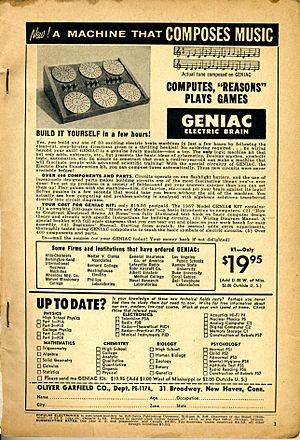Geniac facts for kids
Geniac was a special educational toy that was sold as a "computer". Edmund Berkeley and Oliver Garfield created it in 1955. Oliver Garfield continued selling it into the 1960s. The name Geniac stood for "Genius Almost-automatic Computer." It also sounded like a mix of "genius" and "ENIAC", which was one of the first big electronic computers.
Contents
How Geniac Worked
Geniac was like a building set made of rotary switches. It had six round masonite disks with holes. You could put brass jumpers into the back of these disks. These jumpers made electrical connections between brass bolts. Wires were attached to these bolts behind the panel.
The Geniac circuit included a battery. Wires went from the battery to the switches. Other wires connected the switches to small flashlight bulbs. These bulbs lit up to show the results. Finally, wires went back to the battery to complete the circuit.
Simple Logic, No Memory
With this setup, Geniac could only use combinational logic. This means its answers depended only on the inputs you set by hand. It didn't have any active parts like relays or transistors. This meant Geniac couldn't automatically change its own state.
Because of this, Geniac did not have memory. It couldn't solve problems that needed steps to happen in a certain order. You, as the operator, had to do all the steps manually. Sometimes, the instructions were quite tricky! For example, they might say: "Turn this wheel if this light turns on."
The Geniac came with a main instruction book. It also had another book with wiring diagrams. These books showed you how to set up the jumpers and wires. You could build many different "machines" that solved complex logic problems. The kit even included a copy of Claude Shannon's important paper on how switches work in circuits.
A Fun Project: The "Masculine–Feminine Testing Machine"
One popular project you could build was a simple "Masculine–Feminine Testing Machine." This machine helped users answer five questions about gender. For example, one question was: "Which makes a better toy for a child: (a) electric train? (b) a doll with a complete wardrobe?"
To use it, you would wire five of the six rotary switches. You would set them to "off." Then, you would answer the questions. For each "a" answer, you would turn a switch to one "on" position. For each "b" answer, you would turn it to the other "on" position. The machine's circuits would then sense your answers. If you had three "masculine" answers, a "more masculine" light would turn on. If you had three "feminine" answers, a "more feminine" light would light up.
Geniac's Popularity
Geniac was advertised a lot in magazines like Galaxy Science Fiction. For many young people, Geniac was their first chance to learn about computer ideas. It also taught them about Boolean logic in a hands-on way.
Brainiac: A Similar Product
In 1958, Edmund Berkeley introduced a very similar product called Brainiac. He launched Brainiac after he and Oliver Garfield stopped working together.


